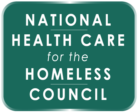Cognitive Impairments
Adapted Clinical Guidelines
Adapting Your Practice: Recommendations for the Care of Patients Who Are Homeless or Unstably Housed Living with the Effects of Traumatic Brain Injury | 2018 | National Health Care for the Homeless Council
Healing Hands Newsletters
Additional Resources
Traumatic Brain Injury and Substance Use Disorders: Making the Connections | 2021 | Author: Carolyn Lemsky, PhD, C Psych ABPP-CN
Editors: Patricia Stilen, MSW and Thomasine Heitkamp, LCSW – This toolkit merges the content on traumatic brain injury (TBI) and substance use disorders (SUD) to expand the capacity to address both issues in treatment. It is a resource for behavioral health treatment providers, healthcare providers, educators, and health and human service administrators to gain a deeper understanding of the impact of SUD on persons who have survived a TBI. The merging of the two fields expands the capacity of providers to address both concerns, with a specific recommendation for treatment protocols and screening tools.
Traumatic Brain Injury Among Homeless Persons: Etiology, Prevalence & Severity | 2008
This monograph by Jennifer L. Highley, PMHNP-BC, and published by the HCH Clinicians’ Network, describes the etiology, prevalence and severity of cognitive dysfunction as a result of traumatic brain injury (TBI) among persons experiencing homelessness. It is hoped that this information will improve our ability to identify, assess, diagnose, treat, house and create aftercare services for those homeless persons who have sustained TBI and other insults to the central nervous system. The paper concludes with a series of practice, administration and policy recommendations.
Traumatic Brain Injury in a Homeless Male | 2008
Traumatic brain injury (TBI) is a leading cause of disability in the United States, where about 1.4 million people have a reported head injury each year. There is evidence that homeless individuals experience a greater incidence of severe head injury than the general population. This case report illustrates the sequelae of a moderate traumatic brain injury and comorbidities in a young homeless adult.
